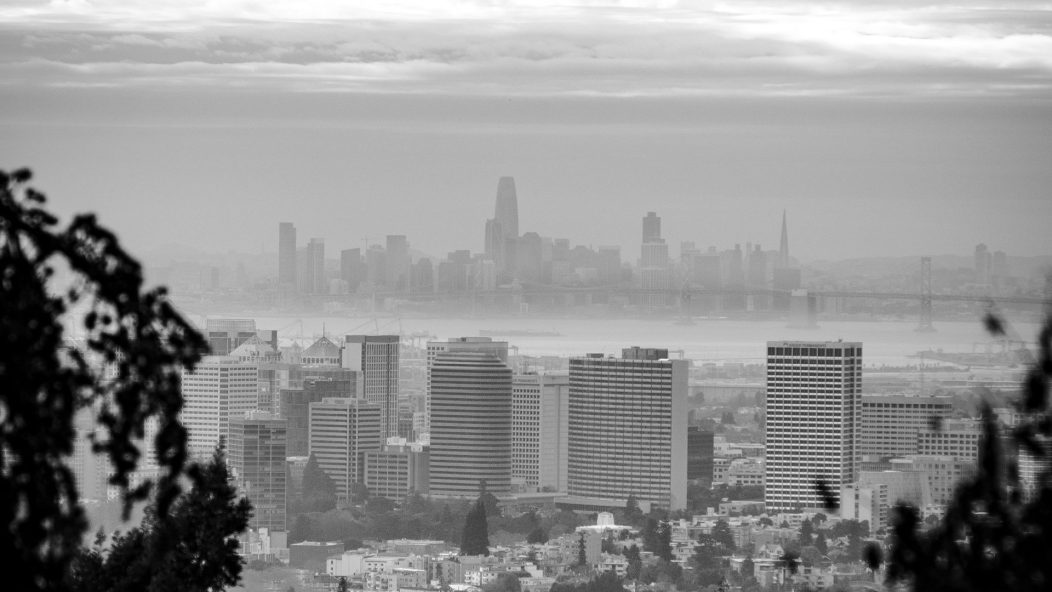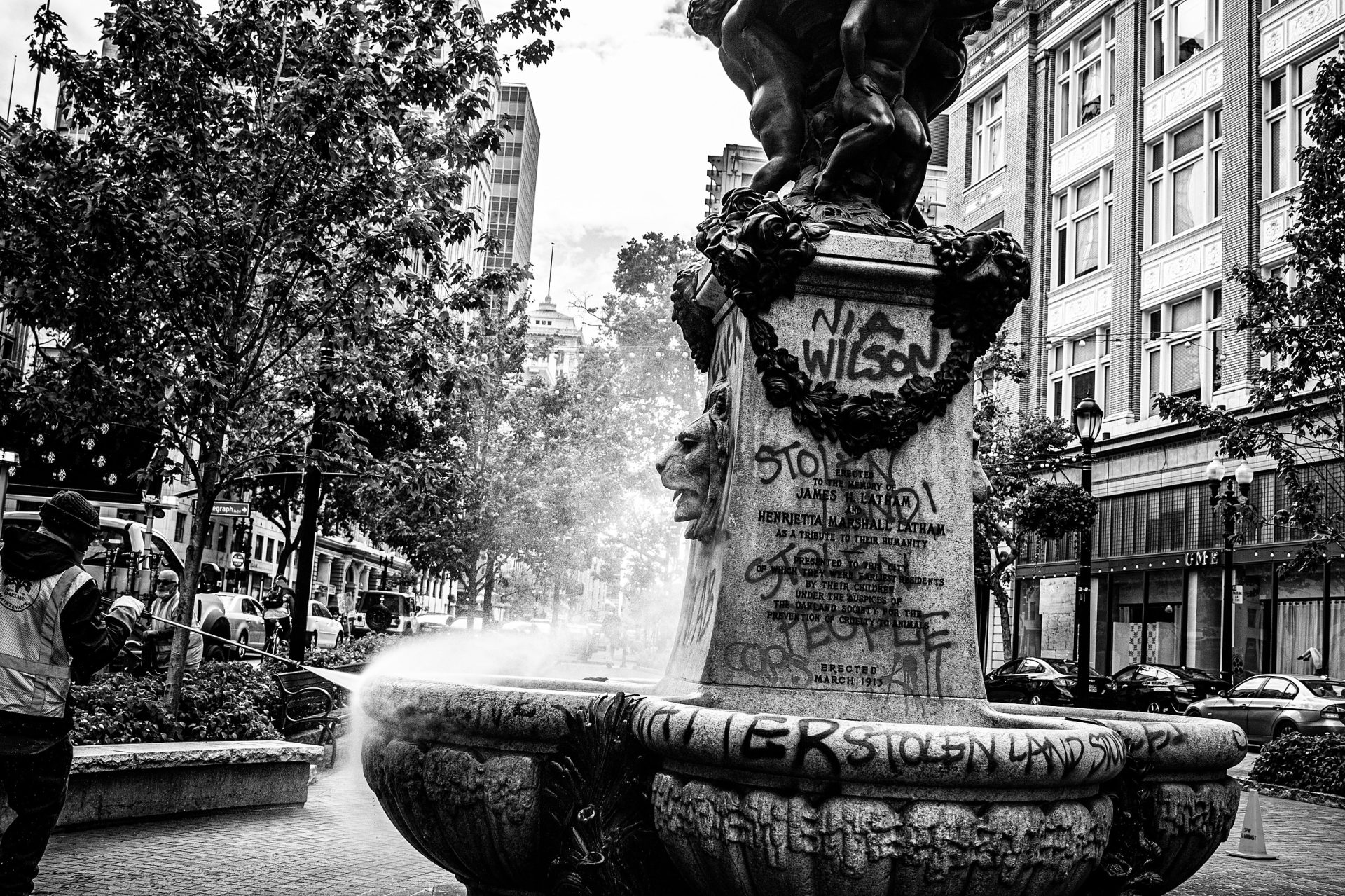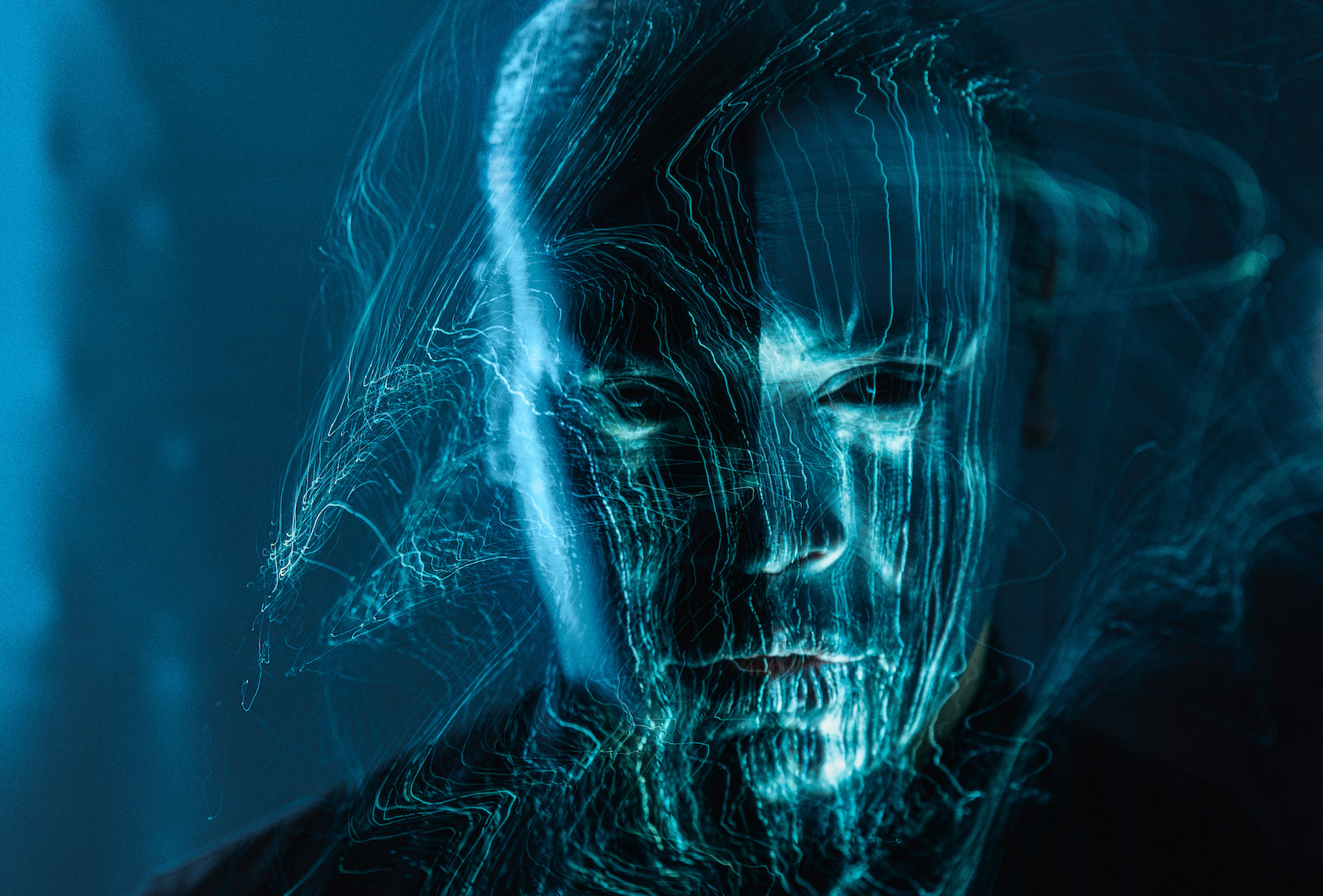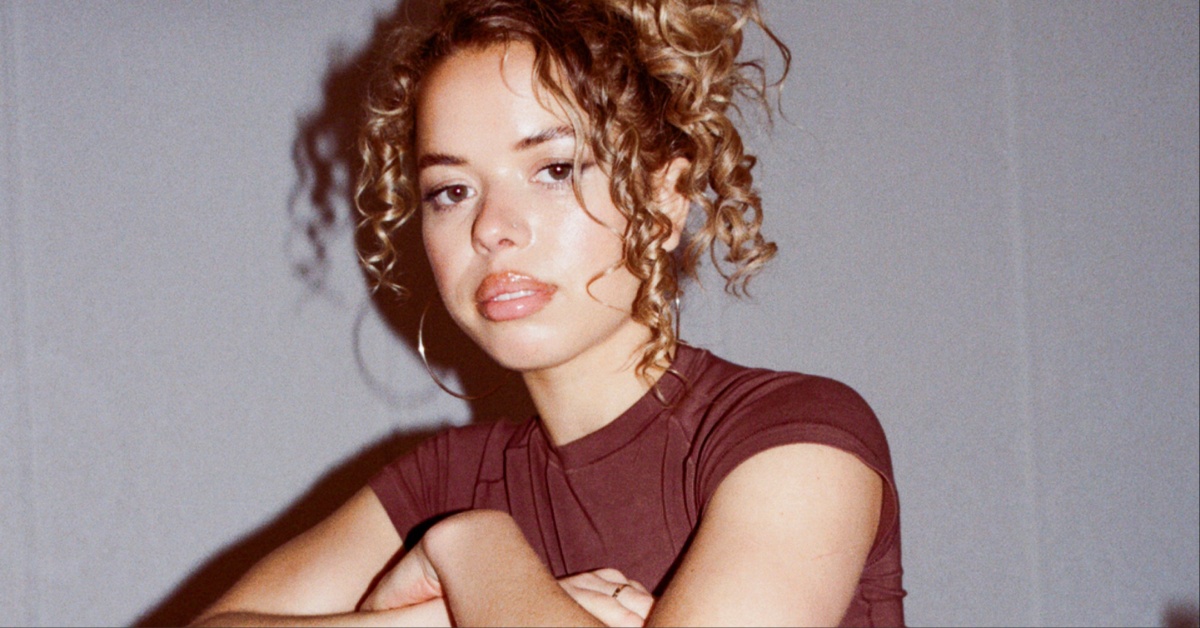
Scene Dive #2: Bay Area Death Metal’s Perennial Resurrection
This article is the second in a series exploring different cities’ extreme music scenes, taking you to the venues, rehearsal spaces, record stores, and other places where the heart of metal beats in locations around the world. This Scene Dive takes you into the world of death metal lurking in the fog of San Francisco Bay.
Countercultural paradise. Tech-bro gentrification wasteland. The San Francisco Bay Area is many things at once in the American psyche. Regardless of whether it’s ill-conceived redevelopment or a housing crisis on full display, recent history paints a turbulent picture of California’s oldest metropolis. Though Silicon Valley moonshots and the state’s various calamities have dominated the narrative, the Bay Area remains a mecca for envelope-pushers, including its death metal disruptors. California has always been a dry place that produces a bounty at the fringes.
“Even in the face of hypergentrification, and with many people leaving the Bay Area for more affordable places to live, somehow musicians keep moving here and start[ing] new bands,” says Leila Abdul-Rauf. The recent wave of death metal has seen a major cohort of bands like Vastum (in which Abdul-Rauf handles vocals and guitars), Necrot, Ripped to Shreds, Mortuous, and many others channel the remains of the classics while pushing deeper into unknown territory. The scene is talent-rich, although local difficulties have caused clampdowns. With each loss comes a gain, though: as in cities like New York, the cycles of this ecosystem benefit from a constant influx of new ideas, some because and some in spite of the rising tides of the tech boom.
…

…
“A SUDDEN AND RAVENOUS DISCOVERY PROCESS”
The Bay Area’s metal scene wouldn’t be the same without its close association with punk. Labels like Tankcrimes thrive where the genres meet, and bands like Dystopia and Amebix had a formative influence on musicians who came up locally.
Chad Gailey, who drums for Vastum and Mortuous and runs Carbonized Records, grew up in San Jose. “I learned how to play the drums by listening to the Ramones, G.B.H., Discharge, Adolescents, The Adicts, etc.,” he says. Punk led him to crust. “Doom, Nausea, Conflict, Crass, and Amebix became my regular go-tos,” he says. “It wasn’t until I was starting one of my first bands that I started hearing bands like Cannibal Corpse and Napalm Death.: Propelled by the rise of East Bay thrash and interest in local bands like Asunder, Graves at Sea, Brainoil, and Laudanum, he and his friends often made the drive up to Oakland for shows in the early 2000s.
…
…
Unlike Gailey, many who now play in prominent local metal acts moved to the city later in life. Whether for work, closer contact with the underground, or simply to get away from home, musicians of all stripes come and go, bringing their own influences and ideas and leaving changed by what they find in California. “The Bay really exposes you to a breadth of art and culture which can be very inspiring, particularly if you’re not natively from here but end up here later in life,” says M., the owner of Sentient Ruin Laboratories. “At that point, through local records, stores, venues, bands, musicians, [and] labels, it becomes a sudden and ravenous discovery process.” This sudden and ravenous discovery process catalyzed the formation of a wave of bands like Exhumed and Impaled in the early ‘90s and a fresh wave of bands in the early 2010s.
Record stores have played a sustaining role in the scene, as well. M. cites local mainstays such as Econo Jam Records and 1234 Go Records in Oakland, Amoeba Music in Berkeley and San Francisco, and Thrillhouse Records in San Francisco as prominent places to find LPs from the underground. Though backups at pressing plants have snarled newer releases, the Bay’s deep bench is on display alongside records from farther afield.
Geography is part of the cause of this deep bench. The sheer size of the Bay Area offers musicians a variety of options when honing their craft. Justin Ennis, local promoter and drummer for acts like Ulthar and Vale, says, “I don’t know most people’s address. I can say that the scene here is pretty spread out. I know of a few folks that drive over an hour to come to shows.” The Bay Area’s polycentric nature means that local microcultures exist in San Jose as well as Oakland and San Francisco, with overlap and longstanding relationships connecting the cities and towns ringing the Bay.
Regardless of specific location, the scene’s DIY roots remain evident. Prior to COVID, house shows played an important role, particularly in punk-leaning hardcore and crust circles. While house shows remain scarce, the recent autumn lull in the pandemic saw music again return to the stage at venues like Elbo Room and the Golden Bull. Unfortunately, many more venues such as the Hazmat and Life Changing Ministry shuttered indefinitely, and COVID variants threaten those that remain in a holding pattern.
Even without the pandemic, venues faced increasing economic pressure accompanied by municipal crackdowns on radical art in the wake of Oakland’s deadliest mass-casualty event of the 21st century. The Ghost Ship fire in 2016 made a lasting negative impact on police tolerance of shows and other counterculture gatherings.
THE GHOST SHIP TRAGEDY
Breaking out during a DJ set put on by house label 100% Silk, the Ghost Ship fire gutted this Oakland artist collective and cost 36 lives. Its immediate impact was felt not just by the electronic scene, but also by punks and metalheads, too. After the fire, Ennis says that “most of the longstanding DIY venues were shuttered by the fire marshalls. There’s still a few spots hanging on, but it’s mostly bars and clubs that welcome extreme music at this point.” The tension between local artists and the police has not improved. Abdul-Rauf says the tragic fire “re-emboldened” the police to take action against underground arts gatherings.
…
…
The fire came just as the forces of gentrification began to have a tangible effect on San Francisco’s formerly vibrant punk and metal scenes. “Some shows in the ‘90’s happened in Oakland at the Omni, but San Francisco had most of the action,” says Gailey. “I think once the late 2000s rolled in, a lot of the venues in San Francisco started to close.” While musicians do still call San Francisco home, venues like the San Francisco location of Elbo Room that had hosted more underground acts since 1991 closed at the end of the 2010s, a process arguably accelerated by police hostility. “The only venues and stores who can sustain themselves here need to profit, and to profit they need to open up to more mainstream events and sacrifice [the] uniqueness and quirkiness of [their] offering[s],” says Sentient Ruin’s M. “The consequences are obvious.”
Perhaps not coincidentally, this has proceeded against a backdrop of tech innovation. Techies living in San Francisco have priced out many musicians, and artists speak of metal’s eastward shift. In one obvious sign of this, the Elbo Room Jack London location in Oakland, opened in 2018, remains in operation. Other Oakland bars such as the Golden Bull continue to host shows, though of course many events have been canceled or postponed due to omicron. “I’m not really aware of any extreme bands that practice in SF [anymore],” says Andrew Lee, who plays in countless bands including Ripped to Shreds. “I think all of them practice in Oakland,” he continues. Butler corroborates that only a few musicians remain in San Francisco. “I don’t see much of a future for death metal in San Francisco,” he says, “but the genre will continue to thrive in other parts of the Bay Area.”
While it’s tempting to read the upswing in underground metal as a reaction against these market conditions, most musicians I spoke to have few direct connections to this economic climate—except, of course, when it comes to housing.
FAULT LINES
Pressure from rising rents and stagnant wages for those not in tech have had a massive impact on San Francisco and Oakland despite the fact that most companies’ headquarters lie over an hour south in Silicon Valley. The evidence is everywhere, from branded transit hubs to burgeoning evidence of a full-blown humanitarian crisis keeping people unhoused. “When rents rose astronomically in the early 2010s, that’s when I noticed a big exodus out of San Francisco into Oakland and East Bay in general,” Abdul-Rauf says. “Of course, that made rents rise in Oakland, too. Honestly, if the Bay Area didn’t have rent control, I doubt many of us would be able to live here as long as some of us have.”
Poverty is hyper-concentrated—some would say by design—in places like the Tenderloin district. “San Francisco’s Tenderloin can be pretty squalid. I’d never seen anything like it when I moved here from New York,” says Daniel Butler of Vastum and Acephalix. “I suppose Vastum and Acephalix are somehow connected to all that; we practiced in the Tenderloin for years.” Butler notes that the effect of being surrounded by addicts had an impact on both bands, who have “a mystical/spiritual orientation that, for some of us, was born of long-term abstinence from mind-altering substances.”
The Bay Area is still a remarkably diverse place. Over a third of San Francisco’s residents self-identify as Asian; nearly 10% self-identify as multiracial. San Francisco’s LGBTQIA+ community was still the nation’s largest as of 2015. The forces of change affect the region’s many communities very differently, and this diversity informs the work of bands like Vastum that explore horror through psychosexual themes.
Lee notes that hardcore has thrived even as many metal musicians move to places like Portland. “Maybe because hardcore skews younger here, and definitely less white?” he wonders, noting that “POC adults tend to live with their parents at a much higher percentage than white Americans do.” Lee cites Creator Destructor Records as a local wellspring of hardcore talent.
…
…
Multiple musicians mentioned Portland by name, though Lee says, “[i]t seems like they’re also reaching saturation over there as well.” With the pandemic surging once more and the Great Resignation currently underway, the long-term effects of this anecdotal heavy-metal brain drain remain unclear. “I’m curious to see how many people stuck around since the pandemic started,” says Gailey.
In the brief autumn lull in COVID precautions, Californians again flocked to their favorite bars and coffee shops. However, the live scene shows signs of permanent change in some parts of the Bay Area—San Francisco is a place of play for those returning from a day at Apple or Meta or their desks at home, which affects the clientele to which bars and venues cater. “Live opportunities at quiet, intimate venues are fewer and further between, and playing ambient music in a bar with people drinking and talking loudly over your set… well, it’s just not fun at all,” Abdul-Rauf says.
But while hovering in uncertainty, and with their gathering places under the stern eye of local police, bands from cities like Oakland and San Jose have continued producing harrowing, heavy extreme music.
“DEATH METAL NEVER DIED”
It’s worth remembering the Bay Area’s history when prognosticating the doom of this, that, or the other cultural asset. San Francisco, Oakland, and other municipalities have weathered earthquakes and economic bubbles before, often emerging stronger on the other side. Much like wildfire can be regenerative, crises can strengthen cities. The region’s artisans have long shifted foci and locations with the ebb and flow of socioeconomic changes.
The Bay Area’s death metal output in the last ten years shows this resilience. New ideas continually flow in—scene stalwarts like Ennis (from New England), Abdul-Rauf (from New York), and Vastum and Necrot’s Luca Indrio (from Italy) show how transfusions of talent can and do offset metal emigration. Against the onset of COVID last year, Ulthar released Providence, a maelstrom of blackened death metal. Necrot released the crushingly heavy Mortal. Ripped to Shreds put out 亂 (Luan). Outside of death metal, Adbul-Rauf also released the hypnotizing experimental album Phantasiai earlier in 2021.
Sentient Ruin has steadily unleashed a long list of punishing records from groups like Altarage, Coffin Lurker, and Edenic Past, among many others. Gailey started Carbonized Records just a few years ago with support from Scotty at Tankcrimes and has seen success despite Gailey’s inability to tour with his bands. “I’ve been actively releasing records now since 2018 and have fifteen releases out or announced, with more albums on the way in 2022,” he says.
…
…
Other bands continue to find new paths through the economic chaos. Butler and Acephalix plan to enter the studio at some point in January and have live dates booked in the fall of 2022. Ennis will be recording with Vale and Ulthar and hitting the road with the latter if all goes to plan. Lee just released his first record as Heavy Metal Shrapnel and is working on a full-length with Brandon Corsair as Reaver. Sentient Ruin has a litany of releases in the works from bands such as Exaltation, Vile Ritual, Hold Me Down, Hexerei, Egregore, and others, and other local labels have far more in the offing.
M. equivocates regarding metal’s future in the area. Outmigration, COVID, and supply chain issues have made life difficult for artists, labels, and promoters. “I think COVID worsened and/or accelerated the process [of change],” they say. “The label is only physically based here, but distribution-wise and roster-wise, it attempts at being globalist.: Yet M. is unequivocal about the Bay’s depth of talent: “Funeral Chant, Dearth, Vale, Succumb, Ulthar, Pandiscordian Necrogenesis, Necrot, Vastum, Acephalix—I could literally sit here all day naming great metal bands from here.”
“It always ebbs and flows; people come and go,” Abdul-Rauf says. “Bands and venues may change, but there will always be a variety of extreme music scenes here, at least that’s how I see it, having lived here for almost two decades.” Her bandmate Butler agrees. “I thought the so-called ‘death metal revival’ would’ve died years ago, but at this point it’s no longer a revival—it’s just death metal, which never died anyway,” he says. “The Bay Area is always going to be a hub for death metal musicians.”
…
In spite of the challenges, the Bay Area is still a refuge for metal. The region’s counterculture has always stayed a step ahead of the forces of capital. Like an earthquake, the tech boom and housing crisis have brought down some extreme music institutions, but the cities ringing the Bay always manage to rebuild. Those making some of the country’s most innovative death metal will doubtless find a way to do the same.
…










